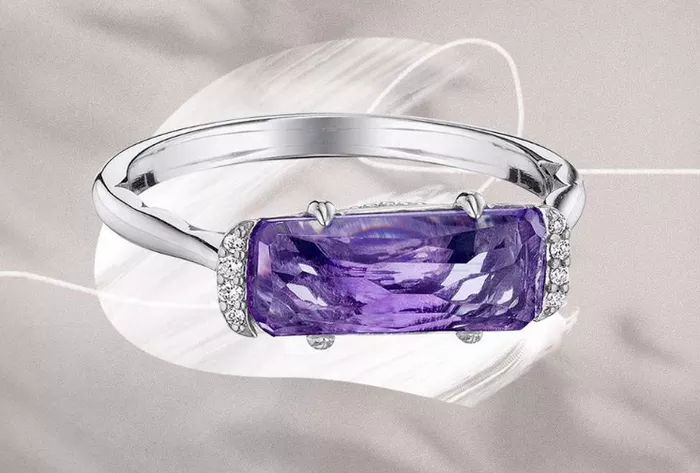Amethyst, with its regal purple hues ranging from deep violet to light lavender, has long captivated jewelry enthusiasts. Whether you’re an avid gem collector or simply appreciate its beauty, distinguishing a real amethyst ring from imitations or synthetic versions is crucial. This guide aims to equip you with the knowledge to confidently identify genuine amethyst, understand its value factors, and recognize common treatments that affect its appearance.
Understanding Amethyst: A Gemological Overview
Before delving into identification methods, it’s essential to grasp what makes amethyst a unique gemstone. Amethyst is a variety of quartz, renowned for its purple coloration caused by traces of iron within its crystal structure. This gemstone’s color can vary significantly based on its origin and the presence of other minerals, creating a spectrum from pale lilac to rich, deep purple.
Key Characteristics of Genuine Amethyst:
1. Color: Natural amethyst exhibits a range of purple shades. The most valuable hues are intense and evenly distributed without zoning (uneven color distribution).
2. Clarity: Like all quartz varieties, amethyst is typically transparent to translucent. Inclusions (internal flaws) are common but should not overly detract from its beauty or durability.
3. Cut: A well-cut amethyst ring will showcase the gem’s color and brilliance. Common shapes include oval, round, and emerald cut.
4. Hardness: Amethyst ranks 7 on the Mohs scale of hardness, indicating good durability suitable for everyday wear.
Differentiating Real Amethyst from Imitations
As amethyst’s popularity has grown, so too have synthetic and imitation versions aimed at the market. Here’s how to distinguish real amethyst from look-alikes:
1. Visual Inspection:
Color Consistency: Genuine amethyst displays consistent color throughout the stone. Be wary of patches of color that appear too dark or too light, as this could indicate dyeing or other treatments.
Natural Inclusions: Look for natural flaws or inclusions within the stone. These are common in natural amethyst and can help confirm authenticity.
Uniformity: Synthetic amethyst often lacks the natural variations found in genuine gemstones. If the color appears too perfect or overly uniform, it might be synthetic.
2. Conducting a Magnification Test:
Loupe Examination: Use a jeweler’s loupe (a small magnification tool) to closely inspect the gemstone. Genuine amethyst should reveal characteristic inclusions or growth patterns that are absent in synthetic versions.
3. Testing Methods:
UV Light Test: Under ultraviolet (UV) light, natural amethyst may exhibit fluorescence. This test, while not definitive, can sometimes distinguish natural from synthetic amethyst.
Specific Gravity Test: Comparing the gemstone’s weight to its volume can provide clues about its authenticity. Natural amethyst has a specific gravity around 2.65, whereas synthetic materials may differ.
See Also: Why Do Bishops Wear Amethyst Rings: Things You Need To Know
Evaluating Amethyst Quality Factors
Beyond authenticity, assessing the quality of an amethyst ring involves considering several key factors:
1. Color Grading:
Hue: The primary purple color of amethyst can vary from reddish-purple to bluish-purple. Pure purple hues are generally more valuable.
Saturation: The intensity of color saturation determines the gem’s visual appeal. Highly saturated stones are more desirable.
Tone: Describes how light or dark the color of the amethyst appears. Medium to medium-dark tones are typically preferred for amethyst rings.
2. Clarity Grading:
Eye-Clean: Amethyst often contains visible inclusions. Stones with minimal inclusions that do not detract from transparency are considered more valuable.
3. Cut Quality:
Faceting: A well-cut amethyst enhances its brilliance and color. Pay attention to symmetry and proportion when assessing cut quality.
Common Treatments and Enhancements
To meet market demands or improve appearance, amethyst may undergo treatments. Understanding these treatments helps in making informed purchasing decisions:
1. Heat Treatment:
Purpose: Enhances color by removing unwanted brownish tones or improving clarity.
Identification: Heat-treated amethyst often displays uniform color and lacks natural inclusions.
2. Irradiation:
Purpose: Alters or enhances color through exposure to radiation.
Identification: Irradiated amethyst may show color zoning or unusual color intensities not found in natural stones.
3. Coating or Dyeing:
Purpose: Enhances color temporarily or masks undesirable features.
Identification: Coatings or dyes may wear off over time or under certain conditions, revealing the true nature of the stone.
Purchasing Tips for Amethyst Rings
When buying an amethyst ring, whether as an investment piece or for personal enjoyment, consider these practical tips:
Certification: Purchase from reputable jewelers who provide gemstone certifications detailing the stone’s authenticity and any treatments.
Ask Questions: Inquire about the origin of the amethyst and any treatments it may have undergone.
Compare Prices: Be wary of unusually low prices, as they may indicate synthetic or treated amethyst rather than natural gemstones.
Caring for Your Amethyst Ring
To preserve the beauty and longevity of your amethyst ring:
Cleaning: Use mild soap and warm water with a soft brush to clean amethyst. Avoid harsh chemicals or ultrasonic cleaners.
Storage: Store amethyst jewelry separately to prevent scratching from harder gemstones or metals.
Avoid Exposure: Protect amethyst from prolonged exposure to sunlight or extreme heat, which can fade its color over time.
Conclusion
Identifying a real amethyst ring involves a combination of visual inspection, testing methods, and understanding quality factors. By familiarizing yourself with these techniques and considerations, you can confidently select an amethyst ring that suits your taste and meets your expectations of authenticity and quality. Whether you’re a collector, enthusiast, or simply someone looking for a beautiful piece of jewelry, the allure of genuine amethyst will continue to captivate for generations to come.

